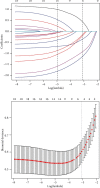A Nomogram Based on Clinicopathologic Features and Preoperative Hematology Parameters to Predict Occult Peritoneal Metastasis of Gastric Cancer: A Single-Center Retrospective Study
- PMID: 33376558
- PMCID: PMC7746455
- DOI: 10.1155/2020/1418978
A Nomogram Based on Clinicopathologic Features and Preoperative Hematology Parameters to Predict Occult Peritoneal Metastasis of Gastric Cancer: A Single-Center Retrospective Study
Abstract
Background: In patients with gastric cancer (GC), peritoneal metastasis is an indication of the end stage and often indicates a poor outcome. The diagnosis of peritoneal metastasis, especially occult peritoneal metastasis (OPM), remains a challenge for surgeons. This study was designed to explore the relationship between OPM and clinicopathological characteristics and preoperative hematological parameters in patients with GC and to develop a nomogram to predict the probability of OPM before surgery.
Methods: A total of 672 patients with GC from our center were included, including 583 OPM-negative and 89 OPM-positive patients. These patients were divided into training and validation groups based on when they received treatment. OPM was diagnosed during surgery in patients without any signs of metastasis through imaging examination. Predictive factors were screened by least absolute shrinkage and selection operator logistic regression of all 18 characteristics. The nomogram of OPM was constructed based on these filtered variables. The discriminative and calibration performance of the model were simultaneously evaluated.
Results: A total of six variables, including tumor size, degree of differentiation, depth of invasion, Glasgow prognosis score, and plasma levels of CA125 and fibrinogen, were selected for integration into the final predictive nomogram. The area under curve (AUC) of the nomogram with six factors was 0.906 (95% confidence interval (CI): 0.872-0.941) and 0.889 (95% CI: 0.795-0.984) in the training and validation groups, respectively. Calibration plots of the nomogram in the two sets revealed a good consistency between predicted and actual probabilities. Decision curve analysis showed that the nomogram had a positive net benefit among all threshold probabilities between 0% and 82%. This nomogram was superior to models incorporating only clinicopathologic or hematologic features.
Conclusion: Both clinicopathological and preoperative hematological parameters are significantly associated with OPM. The nomogram constructed with six factors could be used to calculate the probability of OPM and identify the high-risk population in GC. This may be helpful for early detection of OPM in patients with GC.
Copyright © 2020 Chao Yang et al.
Conflict of interest statement
The authors declare that they have no competing interests.
Figures





Similar articles
-
Prediction of occult peritoneal metastases or positive cytology using CT in gastric cancer.Eur Radiol. 2023 Dec;33(12):9275-9285. doi: 10.1007/s00330-023-09854-z. Epub 2023 Jul 6. Eur Radiol. 2023. PMID: 37414883
-
Establishment and verification of prediction model of occult peritoneal metastasis in advanced gastric cancer.World J Surg Oncol. 2023 Oct 13;21(1):320. doi: 10.1186/s12957-023-03188-2. World J Surg Oncol. 2023. PMID: 37833730 Free PMC article.
-
[Establishment of risk evaluation model of peritoneal metastasis in gastric cancer and its predictive value].Zhonghua Wei Chang Wai Ke Za Zhi. 2017 Jan 25;20(1):47-52. Zhonghua Wei Chang Wai Ke Za Zhi. 2017. PMID: 28105619 Chinese.
-
A nomogram composed of clinicopathologic features and preoperative serum tumor markers to predict lymph node metastasis in early gastric cancer patients.Oncotarget. 2016 Sep 13;7(37):59630-59639. doi: 10.18632/oncotarget.10732. Oncotarget. 2016. PMID: 27449100 Free PMC article.
-
[Establishment and validation of a predictive nomogram model for advanced gastric cancer with perineural invasion].Zhonghua Wei Chang Wai Ke Za Zhi. 2020 Nov 25;23(11):1059-1066. doi: 10.3760/cma.j.cn.441530-20200103-00004. Zhonghua Wei Chang Wai Ke Za Zhi. 2020. PMID: 33212554 Chinese.
Cited by
-
The Burden of Peritoneal Metastases from Gastric Cancer: A Systematic Review on the Incidence, Risk Factors and Survival.J Clin Med. 2021 Oct 23;10(21):4882. doi: 10.3390/jcm10214882. J Clin Med. 2021. PMID: 34768402 Free PMC article. Review.
-
Prognostic significance of serum CA125 in the overall management for patients with gastrointestinal stromal tumors.BMC Gastroenterol. 2023 Jan 26;23(1):25. doi: 10.1186/s12876-023-02655-0. BMC Gastroenterol. 2023. PMID: 36703123 Free PMC article.
-
Development and validation of a nomogram for predicting metachronous peritoneal metastasis in colorectal cancer: A retrospective study.World J Gastrointest Oncol. 2023 Jan 15;15(1):112-127. doi: 10.4251/wjgo.v15.i1.112. World J Gastrointest Oncol. 2023. PMID: 36684053 Free PMC article.
-
Application of Circulating Tumor Cells and Interleukin-6 in Preoperative Prediction of Peritoneal Metastasis of Advanced Gastric Cancer.J Inflamm Res. 2023 Jul 20;16:3033-3047. doi: 10.2147/JIR.S414786. eCollection 2023. J Inflamm Res. 2023. PMID: 37497064 Free PMC article.
-
Risk factors associated with peritoneal carcinomatosis of gastric cancer in staging laparoscopy: A systematic review and meta-analysis.Front Oncol. 2022 Oct 28;12:955181. doi: 10.3389/fonc.2022.955181. eCollection 2022. Front Oncol. 2022. PMID: 36387230 Free PMC article.
References
-
- Nakayama I., Chin K., Matsushima T., et al. Retrospective comparison of S-1 plus cisplatin versus S-1 monotherapy for the treatment of advanced gastric cancer patients with positive peritoneal cytology but without gross peritoneal metastasis. International Journal of Clinical Oncology. 2017;22(6):1060–1068. doi: 10.1007/s10147-017-1164-4. - DOI - PubMed
MeSH terms
Substances
LinkOut - more resources
Full Text Sources
Medical
Research Materials
Miscellaneous

